Group A is set to unfold in a high-octane fashion as the dark horses of FIFA Women’s World Cup, Spain look to claim their first scalp against the pacey South African team. Although neither of the two are dubbed to challenge for the title, their quality should not be underestimated. Spain are currently ranked as the 13th team and South Africa as 49th but at the biggest international stage of them all, that usually makes little difference.
This tactical analysis preview will analyse both teams and give you their tactics, weaknesses and ways in which they can exploit the opposition.
Squads
There is good news for both of the teams as neither seemingly have any major absences and will be able to deploy their gala lineups. The one to watch for Spain is definitely their forward and set-piece expert, Jennifer Hermoso while South Africa will largely rely on the skill and talent of Janine van Wyk, the experienced central defender.
This becomes even more interesting since the two are likely to constantly clash against each other in direct duels during the game, which is a timely metaphor for the whole game: can Hermoso lead Spain’s relentless attacks to victory or will van Wyk manage to keep her defence at the level needed against such a dangerous opponent?
Spain will look to establish dominance
At this point, we can already talk about a certain philosophy flowing through all editions of Spain’s national teams. Just like the men’s team, their “better halves” have a highly distinct, fast-paced, direct, technical and creative approach to their games. Following their traditional style, Spain will definitely look to dominate possession and build all the way from the back and through a series of short but accurate and penetrative passes.
During their build-up play, we can almost certainly expect Spain to push high up the pitch and position their players in different zones, enabling them to progress the ball with a multitude of open channels at the same time. Notice in the image below how their players are occupying different spaces and how each player offers multiple different passing options once she receives the ball.
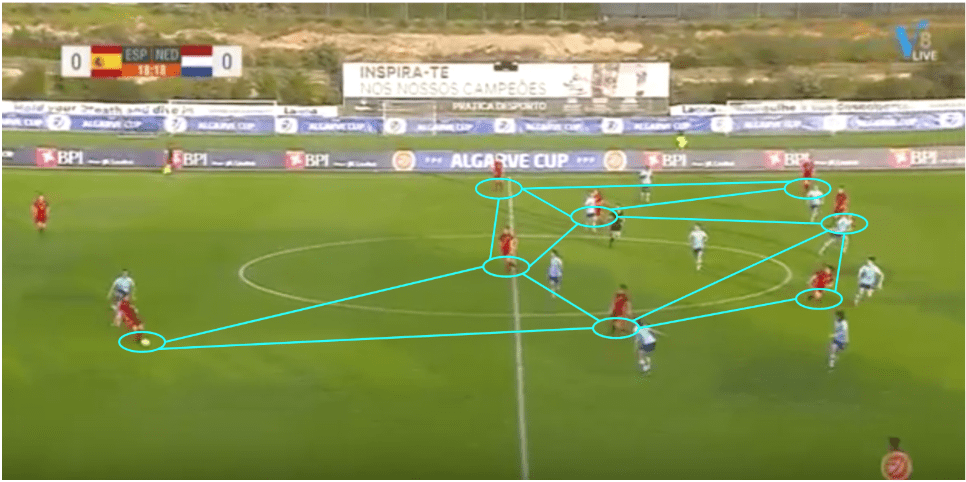
Indeed, this is Spain’s most dominant trait and one they utilise to the fullest in order to string successful and piercing passes. But since they mostly face teams that have inferior possession of the ball, a defensive mid-to-low-block is often used to somewhat dampen their efforts.
In those cases, they will look to stretch the opposition and put players in-between the lines in order to find gaps in the compact blocks. When that yields unpreferable results, Spain tend to combat numbers within the opposition’s side with numbers of their own.
That often means pushing forward with multiple players and manipulating the defensive players out of their shape via dribbling and fast ball circulation. In the example below, the centre-backs push forward and attract the attention of the pressing squad. This, in turn, creates gaps for them to exploit and push the ball in the more dangerous zones.
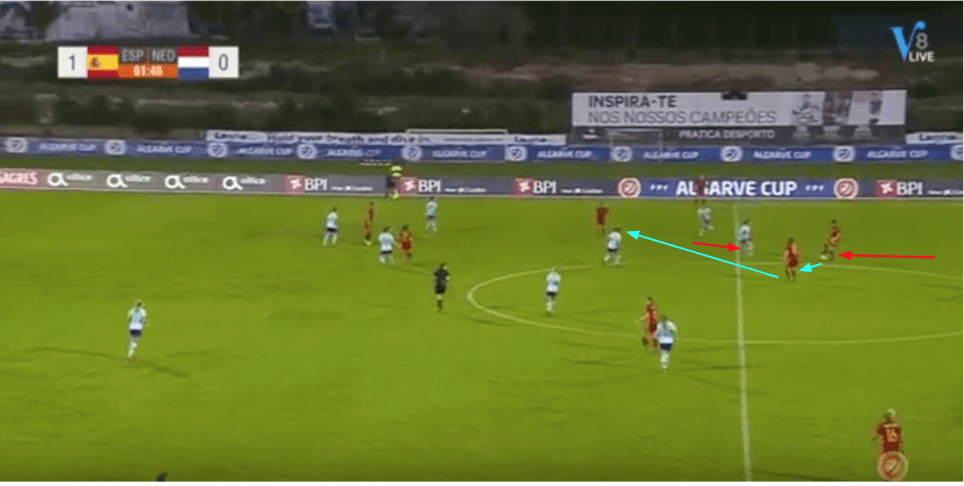
The same thing can happen with the forwards and the midfielders – the interchange of positions by either dropping deeper or moving higher up the pitch, often makes the defenders break their shape and challenge for the ball, leaving pockets of free space behind their backs. This is when Spain is most dangerous and, even more importantly for this match, when South Africa are quite vulnerable.
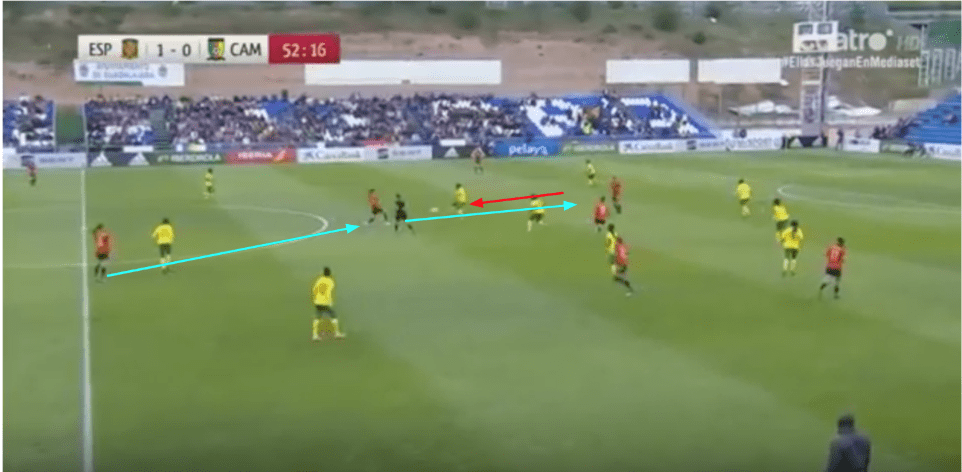
Looking at the other side of the pitch, their African adversaries usually prefer a similar approach themselves. When they have the time and space, none of which they should expect against Spain, they also like to build from the back in a system that often resembles a 4-2-3-1.
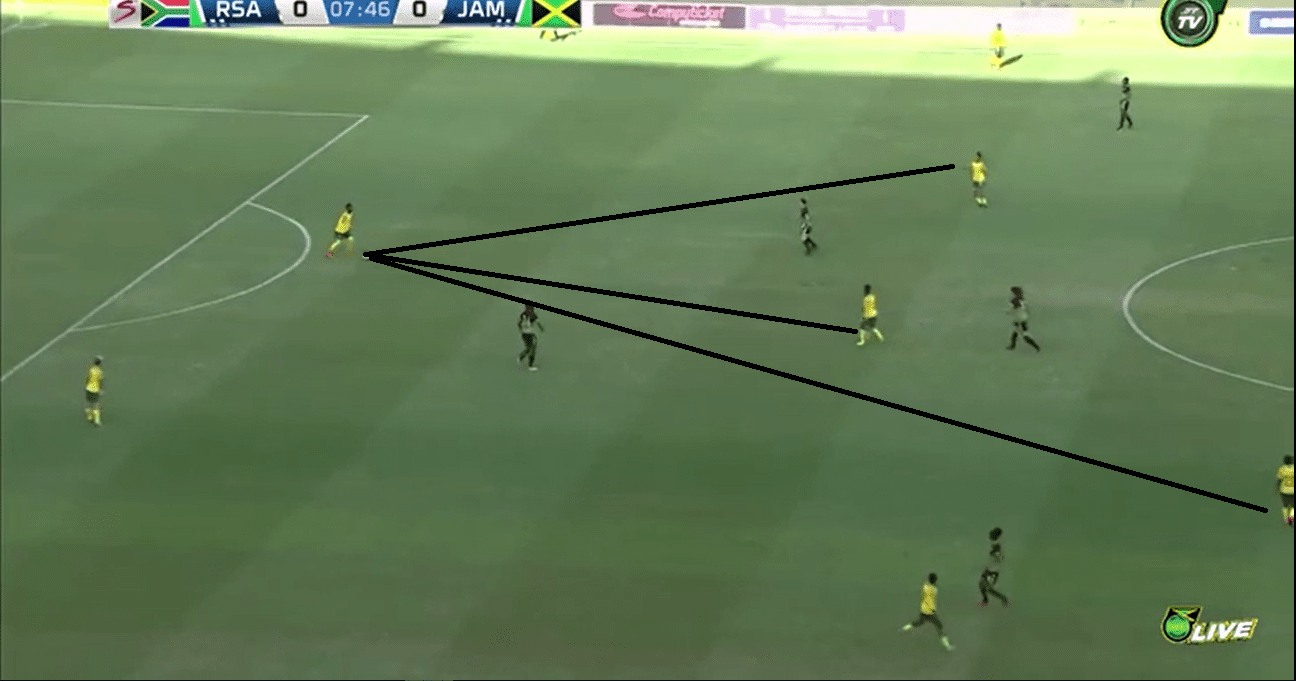
Usually, they set up a double pivot to let them help progress the ball up the pitch but the problems start occurring when they get pressed hard as their system crumbles and positioning is hardly maintained. They tend to have both technical and systematic issues in their build-up phase and facing Spain’s press could very well spell trouble for them. More on that a bit later.
Spain’s counter-pressing and South Africa’s attacking aspirations
As a general rule of thumb, there are a couple of things we can certainly expect from Spain: possession dominance, full-back overlaps and fast-paced counter-pressing. Those three traits are what essentially defines this talented group of players. Their build-up does start from the back and they usually swap from a 4-1-4-1 to a 4-3-3 with one of the defensive midfielders often dropping back in the lavolpiana position (think Sergio Busquets at Barcelona).
However, when they eventually manage to pass their way through to the final third and the danger zones, they have a specific way of attacking in a rather narrow shape. Their wingers tuck in, which lets the full-backs overlap.
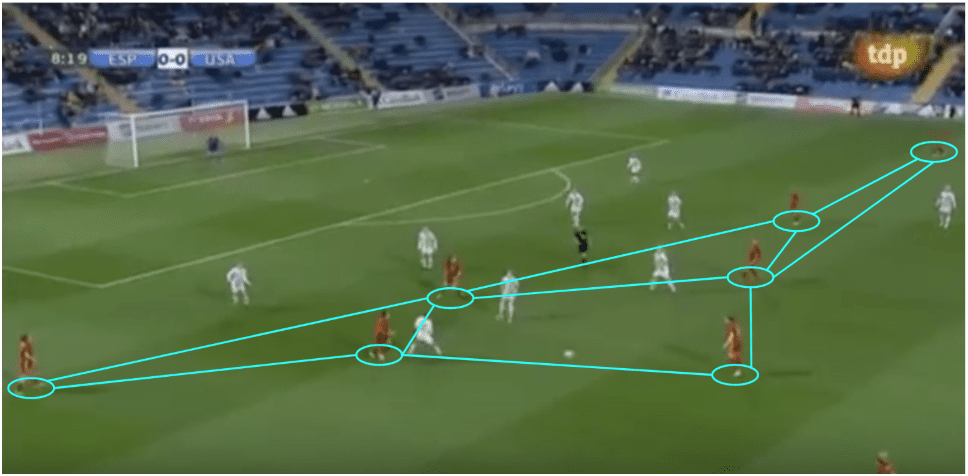
This might very well be key against South Africa as their opposition prefers the low-block but with a not so compact defensive system. Dragging their markers out of position and stretching the backline will thus be crucial in getting the ball past them. And in this scenario, it is probably where the game will be decided.
If Spain fail to get in-behind South Africa’s block, which will probably be deployed in a more compact state than usual, they will undoubtedly face a possibility of a lot of misplaced passes and failed attempts at creative tricks and risky balls. In those scenarios, they usually resort to a rapid counter-press, trying to retain possession within seconds of losing it.
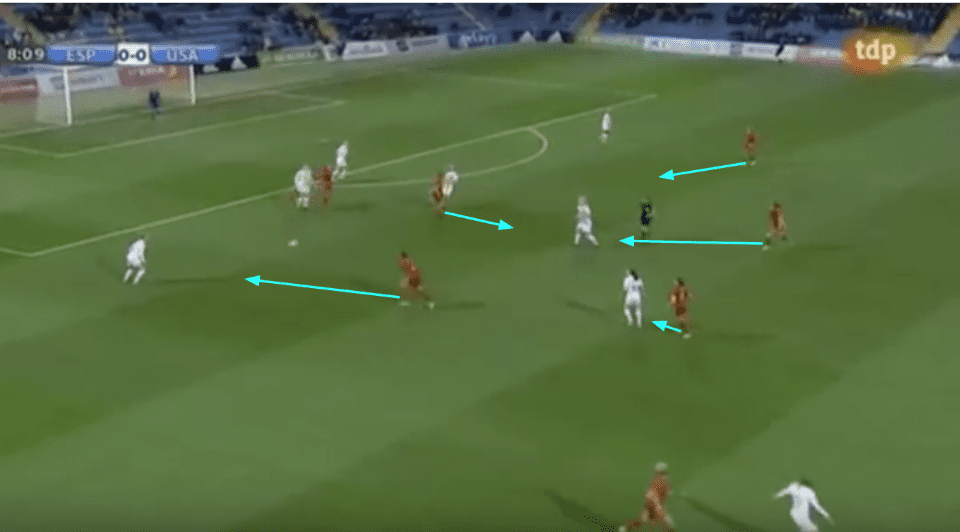
But this does leave them vulnerable, which we will analyse some more a bit later. And where does that leave South Africa then? Well, they will have two options to face Spain’s high press but on paper, it is highly unlikely they can deal with it properly.
Their problems in the build-up phase already showcase that they are most likely not at the same technical level Spain are and in the face of a counter-press, they easily collapse because they don’t make proper use of their positioning.
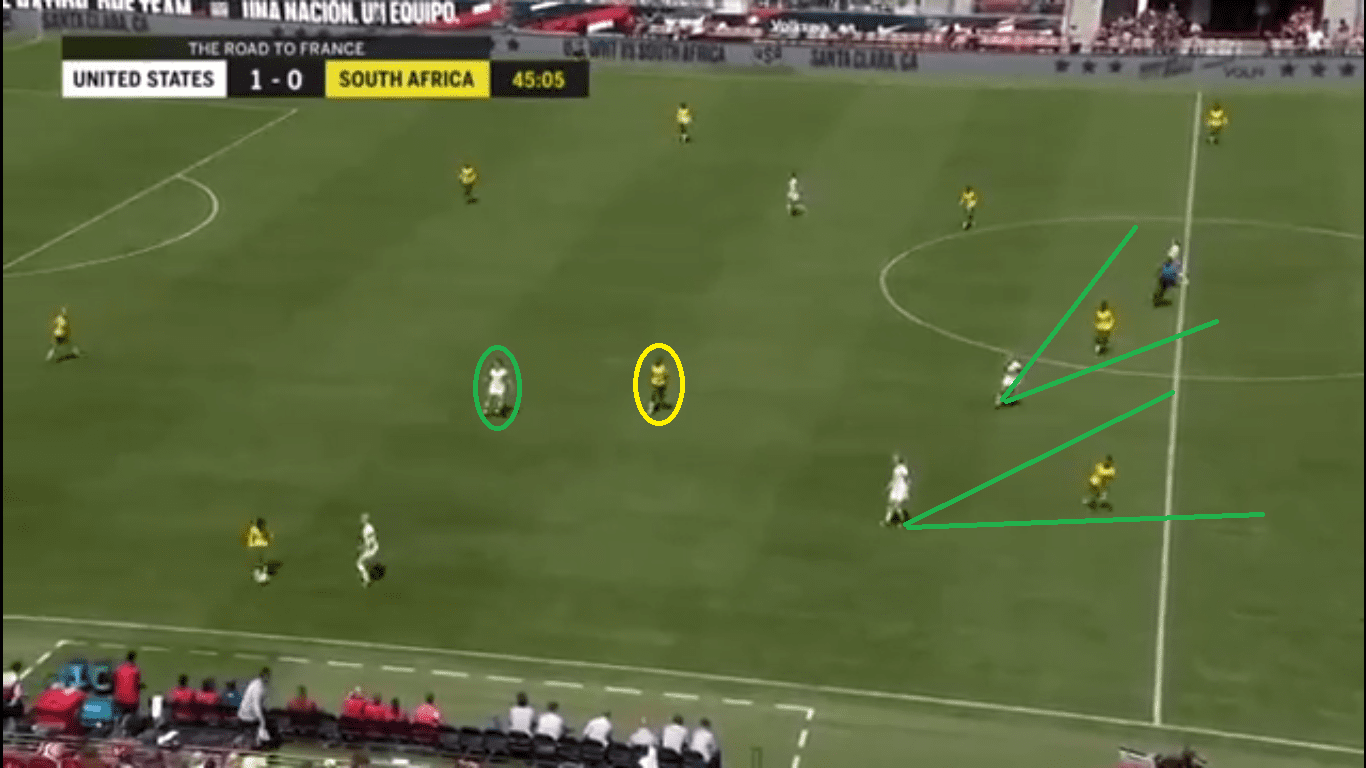
Notice above how the opposition manages to close down all of South Africa’s passing channels and leaves them vulnerable. Spain will definitely look to dispossess them in their own defensive third and strike immediately while the ball is still very much in the danger areas. What South Africa can do in this scenario is hope to find spaces behind Spain’s backs and exploit it with long balls.
This is a trait they do excel at and the first way of two way of overcoming their opposition. Their pacey forwards are known to dash into the free pockets and the unmanned areas of the opponent’s first third, and this might be their only hope going into the game.
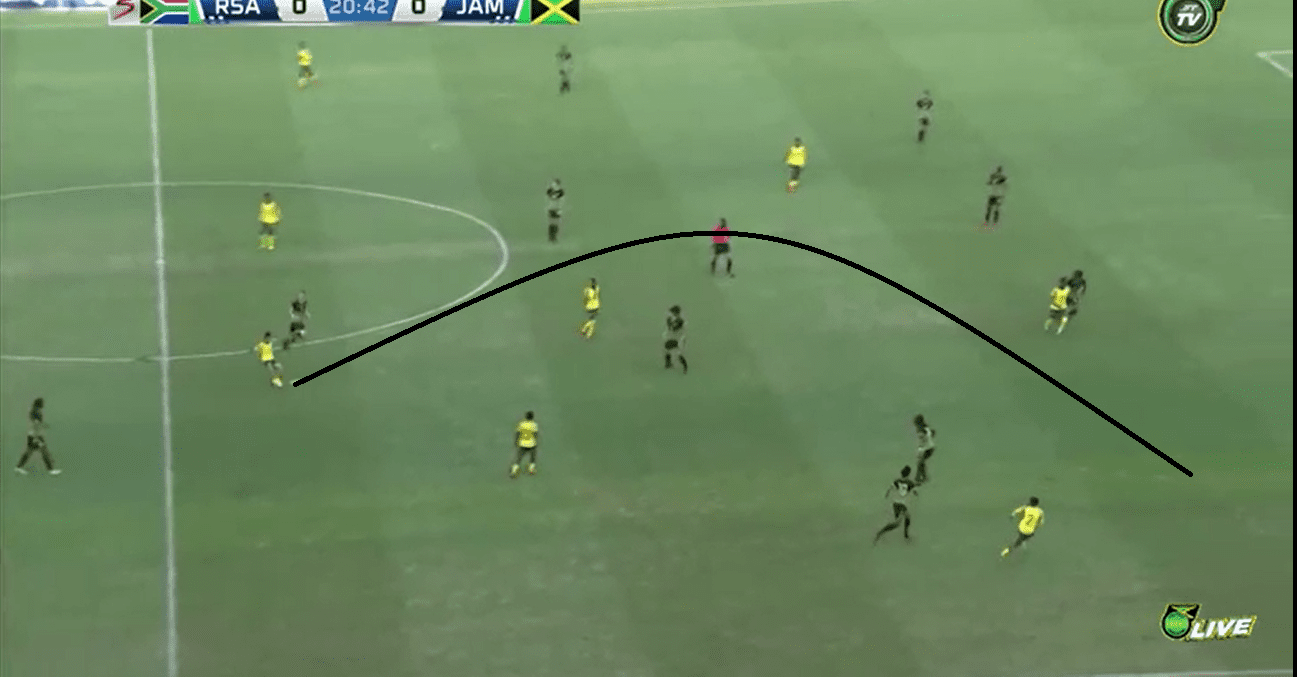
The second way is to make use of the strings of short passes within their own half in order to bypass and outplay Spain’s counter-press. This, however, is a task easier said than done. Not to mention, it’s far riskier and it’s unlikely to be utilised.
Now let’s take a quick look at how both teams can take advantage of each other’s weaknesses in some more detail.
Making the most out of the space
Jorge Vilda’s side, as we now know, play with an extremely exciting, yet excellently organized positional attacks in their 4-3-3 shape. With full-backs going up high, the wide attackers sit narrower and act as inside forwards. Despite having additional width with their defenders’ presence, Spain’s positional attacks are usually focused centrally.
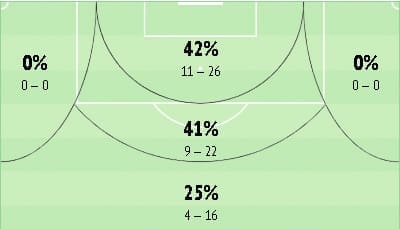
Now with that in mind, South Africa are a team that defend with a combination of man and zonal marking. Usually adopting a 4-2-3-1 formation, they generally defend with a low block, with often nine or 10 men all behind the ball.
But they aren’t exactly a very compact team in defence, neither vertically nor horizontally. Most often this leads to opposing players being able to easily play through the gaps in central areas, which for Spain is a huge advantage.
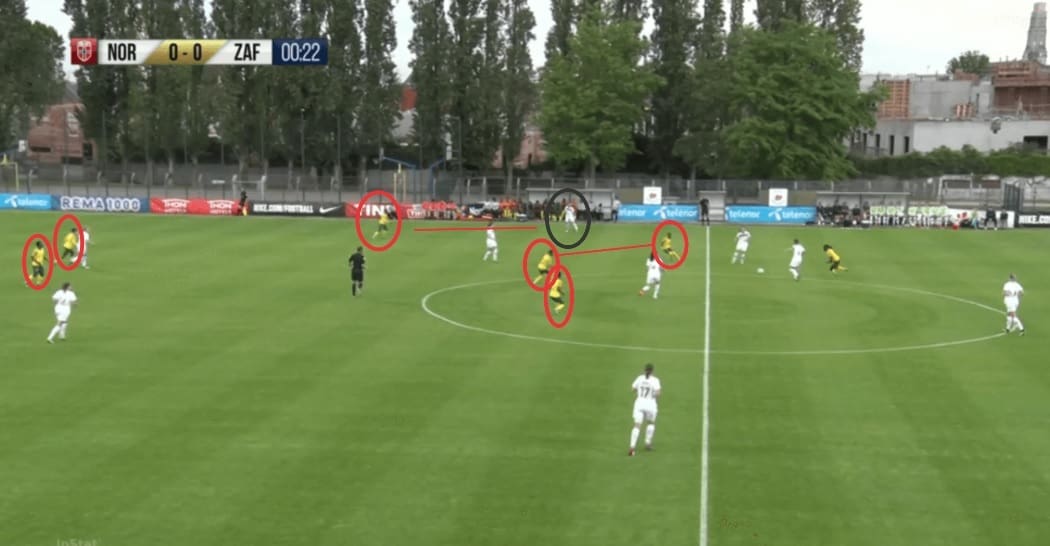
This picture above pretty much sums up a lot of things in South Africa’s defensive approach.
First of all, notice the space between the two lines of players in the middle of the field. Those two players at the back are defensive midfielders, holding their position rather than covering the space and keeping the shape compact. The three-player lineup front is their attacking midfield trio.
Secondly, South Africa would often invite the opposing defenders to advance and play high up the pitch and then start pressing from the halfway line. Spain should be wary of this tactic, although once they managed to get past the first line of pressure, the rest should be rather easy providing they can quickly get players forward and outnumber the remaining defenders.
And thirdly, South Africa’s back four tend to man-mark the opposing attackers, often actively following them around and staying tight This man-marking strategy can be quite effective against teams who have forwards who lacked space and individual skills. But in this game, they are going to be facing Spain, which is a team filled with forwards with fantastic technicality and the blistering pace at their disposal. The full-backs are usually the most vulnerable players to exploit in this case.
As we can also see above, Vilakazi was trying to follow Norway’s wide player as she dropped deep. By doing that she leaves a massive space at the back that could be freely exploited by the opposing forwards.
As for Spain, with full-backs going high and no natural ‘destroyer’ in their midfield, Spain are usually left with only two players at the back and loads of spaces to exploit on the wings. Although Spain play with an aggressive counter-pressing approach after losing possession, if their oppositions manage to break out of it, they’re immediately in immense trouble.
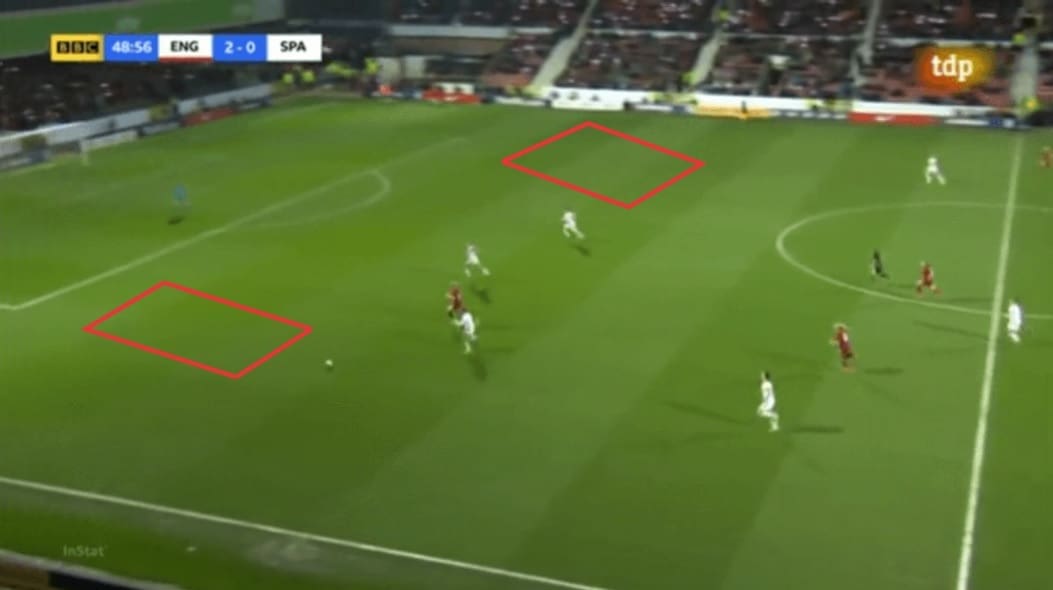
Spain leaving spaces behind. They’re quite vulnerable in defensive transition especially on the flanks as their full-backs usually advance high up the pitch.
If South Africa can produce a flawless, rapid counter-attack and hit Spain in wider areas as they try to transition from attack to defence, they might just be able to cause considerable damage.
Final remarks
Spain are pretty much the big favourite going into this game. They will most likely get a hold of the proceedings on the pitch and dictate the tempo. Their technical superiority and their ability to exploit free space and better yet, create it, is a fantastic asset to have against a team that generally lacks the defensive prowess and compactness in the back.
However, South Africa are not hopelessly outgunned – their chances will come in transitions and in their ability to make great use of Spain’s overly attacking tendencies which often leave them vulnerable, especially if their high counter-press fails to yield any results. The pace and pinpoint long balls will, therefore, be what makes or breaks South Africa’s chances in this game.
If you love tactical analysis, then you’ll love the digital magazines from totalfootballanalysis.com – a guaranteed 100+ pages of pure tactical analysis covering topics from the Premier League, Serie A, La Liga, Bundesliga and many, many more. Get your free copy of the FIFA Women’s World Cup 2019 Preview magazine right here and sign up for a ₤50 annual membership (12 monthly issues plus the annual review) right here.

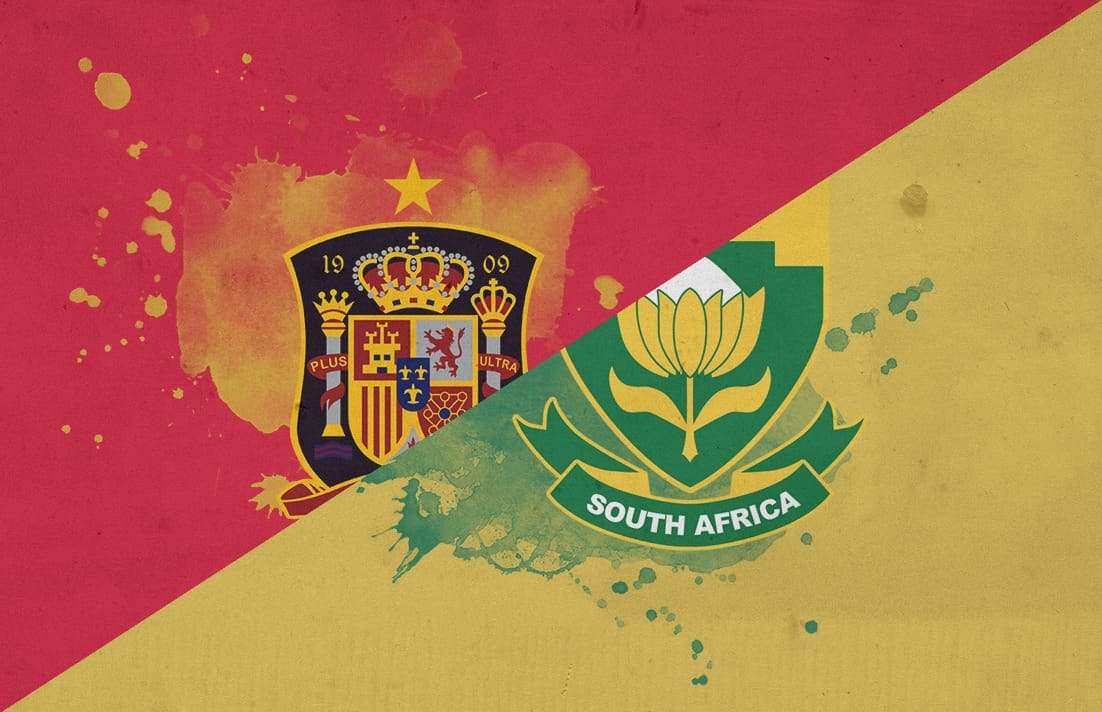




Comments